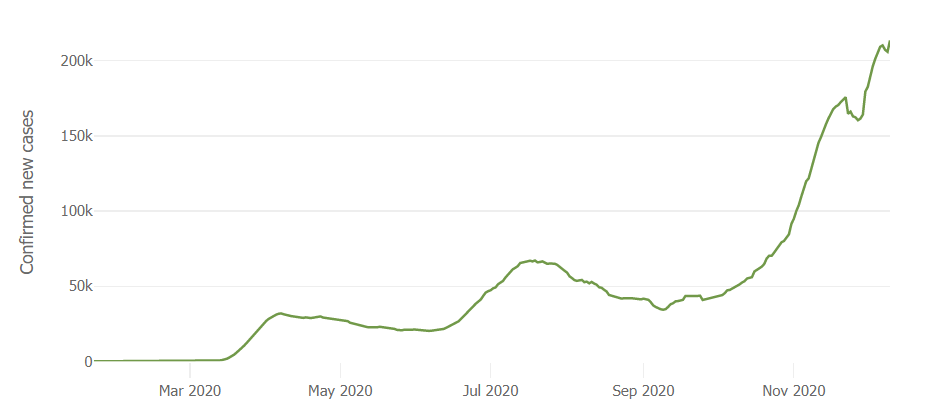When will America re-open?
Simple question on all of our minds, and yet, impossible to answer with certainty. Any forecast is doomed to be partially (if not completely) wrong. The first of the vaccines is arriving this week, and yet, new cases are climbing with abandon. See the chart below from John Hopkins on the daily confirmed new cases (7 day average). Horrific. The line is swimming off the chart. John Hopkins will need to adjust the Y axis here.
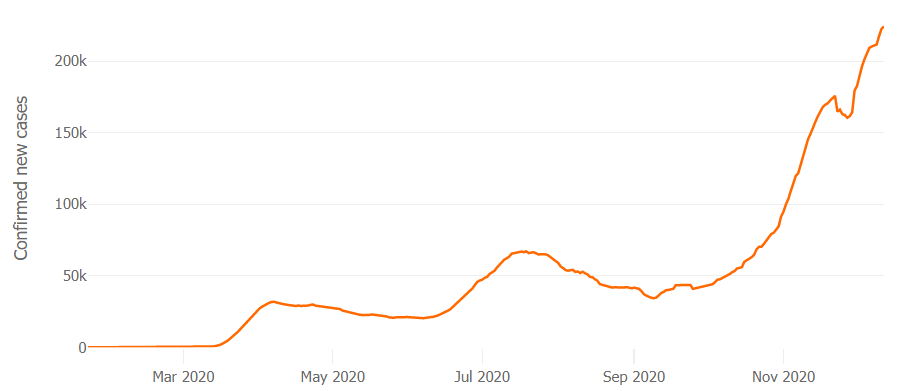
Re-open WHAT for WHOM?
Sensible first question? Before we try to solve a problem, we better have a good idea of what success looks like. After all, re-opening can mean a lot of different things. It’s definitely not a binary 1 or 0. Nope, many different shades of gray.
- How normal? with masks & social distancing vs. just like it was in 2018?
- Where? schools vs. restaurants? urban vs. suburban vs. rural?
- How ubiquitous? adopted here vs. adopted everywhere?
Okay, what information do we have?
When you type “Goldman Sachs” and “Covid-19”, one of the resources you come across is a weekly newsletter called Measuring the Reopening of America. The most recent issue (Oct 21, week 21) is here. Even though its 5-6 weeks old, super useful and creative. Let me explain:
- Useful: tracks 100+ metrics from 20+ different sources
- Useful: trends data for the last 4-5 months, looking for acceleration / deceleration of trends
- Useful: focuses on leading indicators that give us hints about the future
Of course there is macroeconomic and financial data, but it gets WAY better than that:
- Useful: augments with analysis and anecdotes from 14 co-authors from GS investment research
- Creative: sorts data into 3 big buckets “stay at home”, “back to normal”, “business activities”
- Creative: descends into the particulars (e.g., game downloads, dental volumes, refrigerated dough volumes)
1. Stay at Home (what we started doing)
Think of all of the new things you have started or increased over the last half year. Working out at home? Playing videos games? Baking bread? Watching more Netflix? Yes, yes, yes, yes. For me, we’ve tried more recipes in the last 6 months than the previous 20 years of marriage. Many of us have been bunkered in our houses, doing lots of stay-at-home stuff. How much of a closed-off, insular life are we living now?
- Grocery sales of refrigerated dough, cleaning supplies, staple goods, and booze (not necessarily in that order)
- Online gaming – downloads, money spent, time spent – to keep yourself entertained while trapped at home
- App downloads – food delivery, at home fitness, video chat, online payments
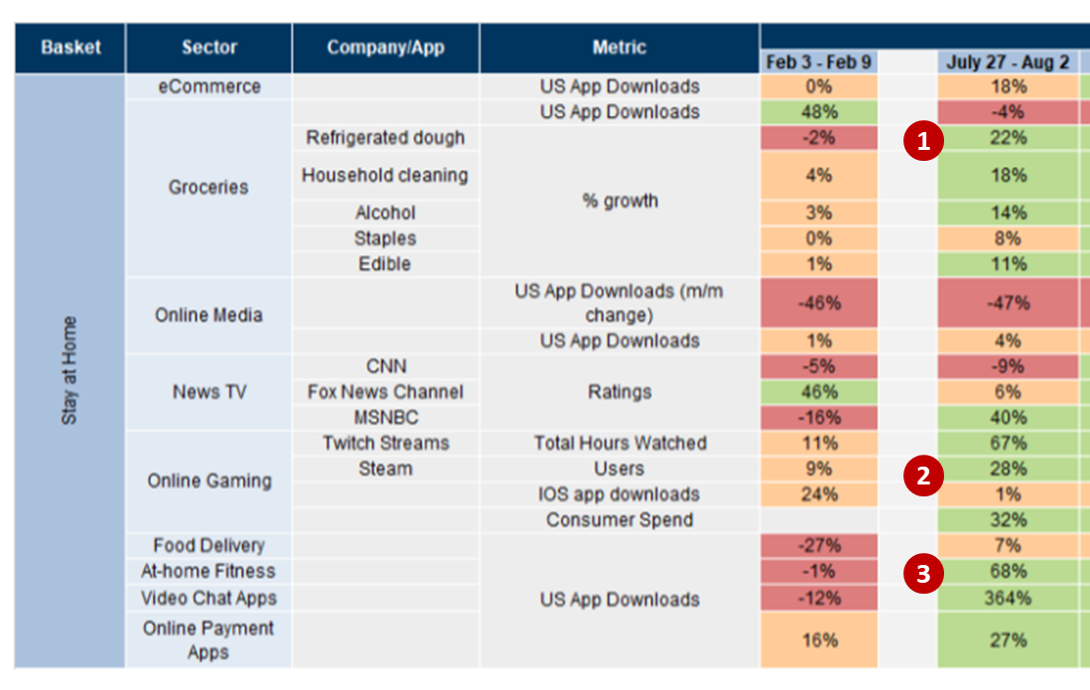
2. Back to normal (what we stopped doing)
The flip side of this is also true. There is a litany of things we stopped doing. Some metrics to track might include:
- Gas demand – drive to where?
- Movies released to the box office – you can see the week of July 27 – August 2, 100% decline
- Restaurant reservations – as tracked by Open Table
- Cosmetics, shaving cream – no to pretty up before “commuting” to the living room, right?
- Hotel occupancy – down from both business and leisure travel stop
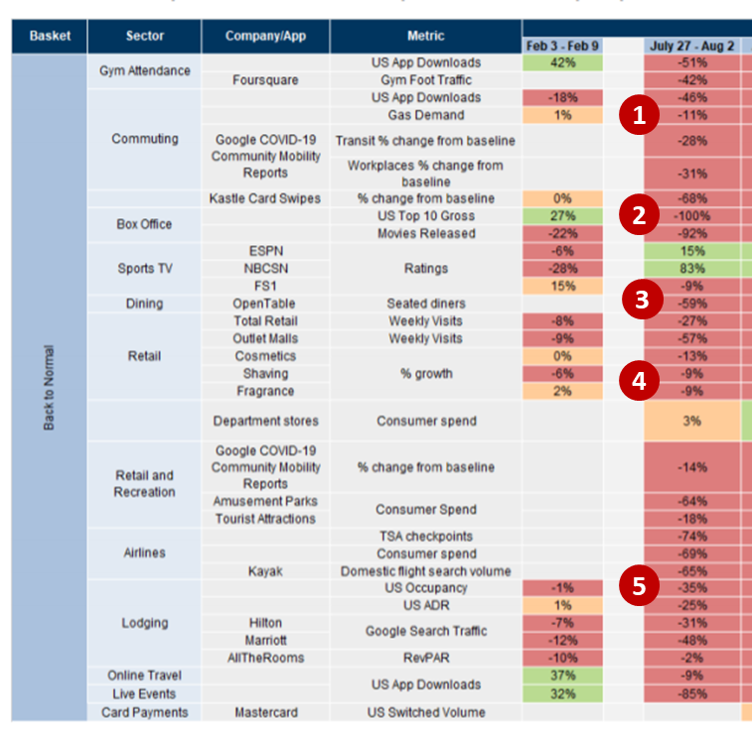
3. Business Activities
The US economy is huge (think: $21+ Trillion), so the list of potential metrics is understandably long. On the left, you see only 10 sectors but the metrics test for different hypotheses and try to pick up different types of signals:
- Inputs to production – things needed to make things (e.g., construction equipment)
- Indicators of trade volumes – more trucks, rails, tires (e.g., intermodal rail containers)
- Sense of business sentiment – bullish or bearing on consumer demand (e.g., advertising)
Perusing a few of the interesting ones:
- Domestic ethanol blending, Google search traffic (quick tip: easy to track)
- Home sales and inventory levels across both existing & new homes; home price trends
- Pricing of trucking, level of intermodal rail containers
- Dental volumes (e.g., pushing out the annual check ups)
- Ratio of branded vs. generic prescription (e.g., cutting costs and buying the generics)
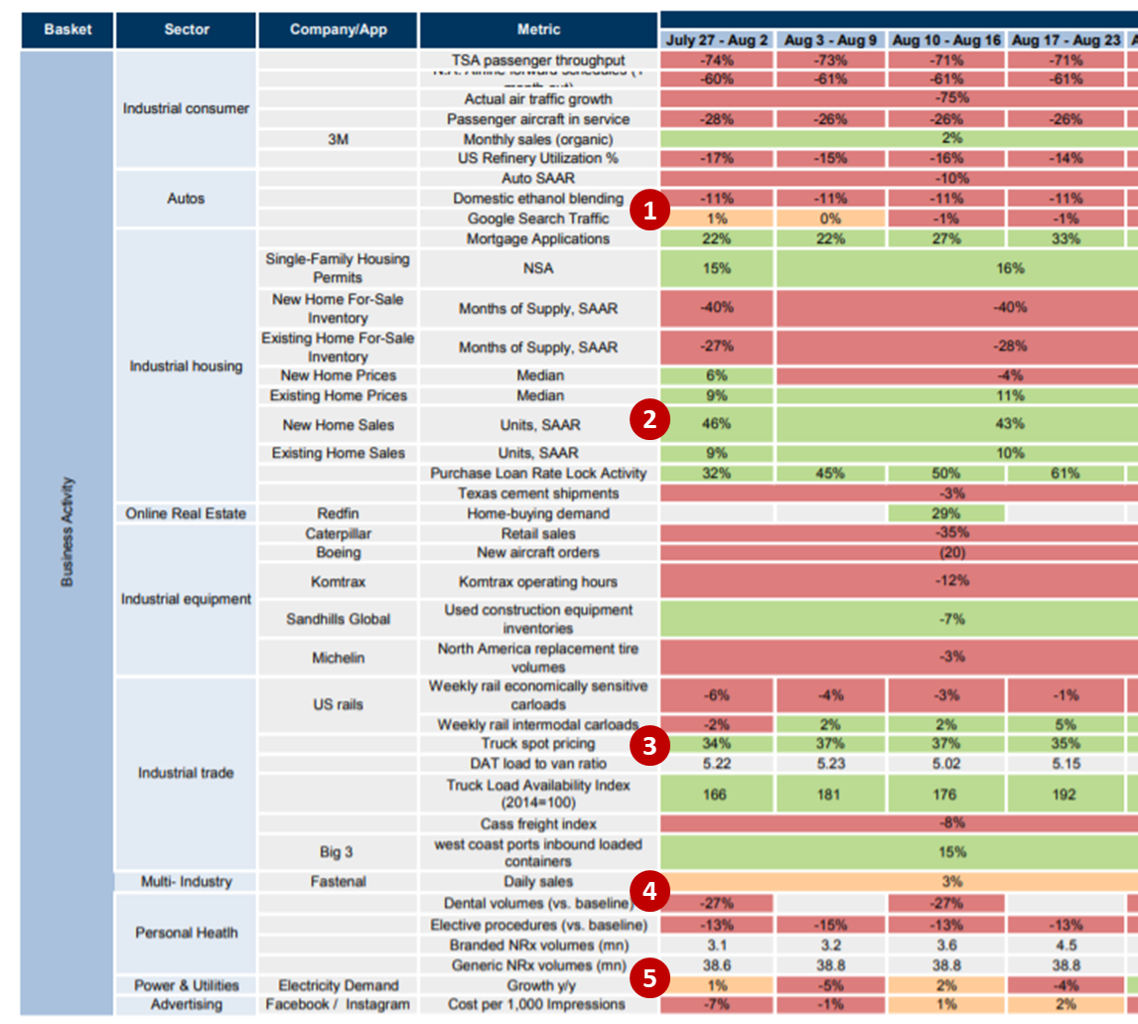
What do the trends look like?
The real power of data happens over time. In the same way that a run chart is more useful than a pie chart. What does the trend look like over 4-5 months? Are there changes (or even acceleration/deceleration) of trends? Of course, refrigerated dough sales is not the magical fortune-reading tarot card, but it can be a weak signal, that gives a sense of the trend. Added together with a hundred other metrics over 20+ weeks, it can tell us something.

Triangulate answers using surrogate data
For me, the genius of this newsletter was the breadth of the measurement, logical structuring of the 3 buckets of analysis (home, normal, business), and the consistency of measurement during those 21 weeks. Basically, these are the weak signals that by themselves are easy to misinterpret. However, when taken together – longitudinally – they serve as cell phone towers that let you triangulate the location (of a better set of answers).
Namely, any framework, tool, approach, scorecard can help us make decisions. It’s not like a multiple choice test answer. Nope, it’s insights that help you make good, human judgement – based on YOUR values, risk-tolerance, and time-frame.
Here’s the link again to read the report yourself (or see the tables with less pixilation) here.
Of course, dashboards are approximate
This approach is not perfect. Goldman Sachs would not debate you on that:
- Most metrics are tracked YoY, but after 1 year of Covid-19 shifted lifestyle, the baseline is dramatically different
- Some metrics are tracked monthly or quarterly, which provides much less granularity
- Markets and products get saturated (e.g., you don’t download ZOOM to your phone every week)
- Lots of interrelation between substitutes, new entrants, prices etc. .
- Customer preference can permanently shift after 6 months (e.g., look at companies moving HQ from CA to Texas)
Covid-19 is the enemy
In conclusion, it’s all about vaccines and smart living. The enormity of unneeded suffering, death, and fear is horrific. Dude – we know that social distancing, mask wearing, hand washing, and ventilation work . . . stick to being smart and informed. Until then, ZOOM beers, baking at home.
